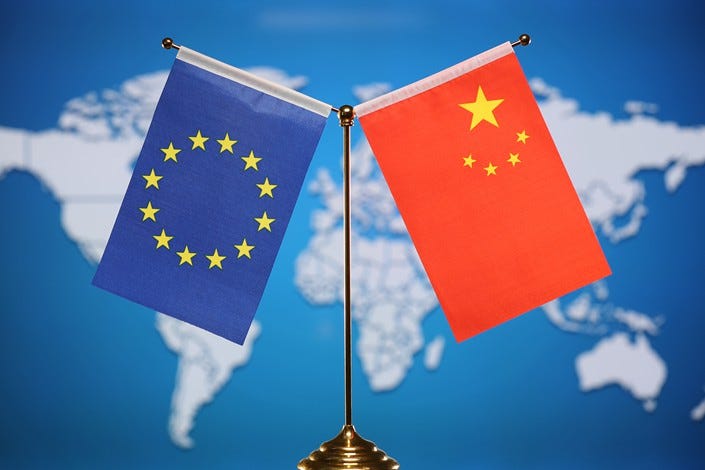Can a standalone ‘EU-China Agreement on Trade-related Regulatory Cooperation’ transcend the political complexities?
Weinian Hu on Why a new technical ‘CAI’ is a pragmatic path forward?
The author is Dr. Weinian Hu, non-resident Senior Fellow at the Center for China and Globalization (CCG). Her research interests include EU-China trade relations and multilateral EU-Asia relations, with a focus on international trade law, patent law, and intellectual property rights protection.
Introduction
Unlike China, the EU has little appetite to relaunch the ratification process for the EU-China Comprehensive Agreement on Investment (CAI). Why would the EU want to finalise the agreement with China – a country it has been actively de-risking since the outbreak of the Covid-19 pandemic?
Currently, as the EU continues to pitch the US to jointly confront China, for example on subsidy – hoping to ease transatlantic tensions – a détente between the EU and China may be seen on the surface, but the prospects of ratifying the CAI remain distant.
Rather than attempting to isolate China – likely to be counterproductive, the EU should foster the conditions and let China fulfil its CAI commitments. Based on the provisional text, the CAI addresses the EU’s grievances over subsidies and state-owned enterprises (SOEs) in a WTO-plus manner with legally-binding enforcement mechanisms.
This commentary will explain why the CAI deserves a second chance. It will argue that, by extracting the regulatory aspects of the CAI, a new standalone technical trade agreement on regulatory cooperation could transcend the political complexities, and deliver mutual benefits. The EU-China Agreement on Cooperation on, and Protection of, Geographical Indications (GI) proves that such an arrangement would work.
Why the CAI deserves a second chance?
Over the past years, China has voluntarily implemented some of the provisions prescribed by the CAI. For example, it has lifted limitations/requirements or implemented national treatment in the financial service sector. The issue of ‘forced technology transfer’ is addressed by, among others, removing the joint venture requirements.
Also implemented are the commitments on environmental protection, such as the submission of the Nationally Determined Contributions (NDC). Additionally, China ratified the two ILO forced labour conventions (C029, C105) in August 2022.
Nonetheless, it is the remaining obligations, e.g. the SOEs’ activities, that hold the key to address the root cause of the EU's grievances. At the same time, fulfilling these commitments could trigger China’s structural reforms which the government has long sought.
As such, the EU and China each has a high stake to revive the CAI.
What remains to be implemented?
The unimplemented provisions are primarily related to structural reforms that China would be required to undertake.
To highlight, China reaffirmed that the activities of its SOEs would be based on the WTO principles of ‘non-discriminatory treatment’ and ‘commercial considerations’. Additionally, beyond the scope of the WTO such obligations would be extended from the goods to service sector. Furthermore, this package of commitments will be bound by the CAI dispute settlement mechanism for enforcement in case of breach.
On subsidy transparency, among others, China has agreed to subject its subsidy programmes for wider public scrutiny – which is equally a WTO-plus commitment. A ‘publicly accessible website’ is expected to be launched for this purpose. For China, such obligations would foster a fairer domestic marketplace where all enterprises, including private ones, can compete on equal terms. The country’s overall competitiveness would be enhanced which is a longstanding objective of the government.
Why the CAI would trigger structural reforms?
Since joining the WTO, China appears to have struggled to advance structural reforms. The lack of ‘external pressure’ and the persistence of ‘vested interests’ internally are two key factors – according to China 2030, a joint research published in 2013 by the World Bank and Development Research Centre, the in-house think tank of China’s State Council.
The research further revealed that ‘vested interests’ – described as ‘likely to be very influential, powerful, resourceful and resolute’ – hindered the government’s ability to build consensus for ‘proactive reforms’.
If the CAI were ratified, the need for ‘consensus’ from the ‘vested interest groups’ would disappear, as implementation would be a legally-binding obligation. This would leave such groups with no room for influence domestically, either. Ultimately, the CAI would trigger China’s structural reforms.
Towards a revamped technical CAI: a standalone EU-China agreement on regulatory cooperation
While its technical merits may be appealing, the political challenges on the EU’s side could threaten to consign the CAI to oblivion.
Prospects of political clearance look distant
The European Parliament holds the key to relaunch the CAI ratification process, which was halted in 2021 following the reciprocal sanctions imposed by the EU and China. Although both parties seem to have explored various ways to lift the sanctions recently, the aforesaid political impediments appear too formidable to overcome. Notably, the Political Guidelines of the EU Commission (2024-2029) frame China as an arch-rival (if not a borderline adversary).
Will a standalone EU-China agreement on regulatory cooperation transcend the political complexities?
Given the circumstances, why not extract the CAI provisions related to structural reforms and establish a new standalone technical EU-China agreement on regulatory cooperation? This way, the trade objectives would be achieved, the sanctions would be irrelevant, and the EU would have an off-ramp from its political deadlock. As illustrated by the EU-China GI Agreement, a technical agreement focusing on a single issue can deliver mutual benefits even amidst a strained relationship.
Conclusion
Despite the current downturn in relations, the EU and China remain top trading partners – which is a foundation for potential collaboration. A standalone regulatory cooperation trade agreement – built on the CAI – could unlock the gains each side has aimed to achieve for decades. It is therefore in the interest of the EU and China to promptly start working towards such an agreement.
Full Text: Xi's Speech to Global CEOs
On the morning of Friday, March 28, Xi Jinping met with representatives of the international business community at the Great Hall of the People in Beijing.




